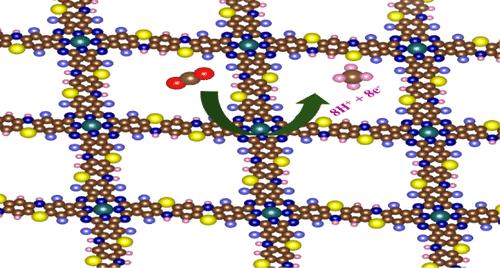揭示金属酞菁基共价有机骨架对CO2还原反应的电催化活性
IF 3.2
3区 化学
Q2 CHEMISTRY, PHYSICAL
引用次数: 0
摘要
将二氧化碳(CO2)电化学转化为化学物质或燃料是加强碳捕获和减少温室气体排放的一种很有前途的策略。然而,寻找能够选择性产生所需产物的高活性电催化剂是该过程的主要障碍。本研究利用密度泛函理论(DFT)计算,分别利用含有硫代喹啉键和二硫胺键的copc - dds - cof (dds)和copc - dds - cof (DSDS)框架,探讨了二氧化碳电化学还原为C1产物的过程。首先,采用周期混合DFT方法分析了三维COFs的结构和电子特性。dds和DSDS均表现出较小的电子带隙(Eg),分别约为0.35 eV和0.44 eV,并且在费米能级(EF)上具有显著的电子态密度(DOS),这由能带结构和总DOS计算证实。为了探索反应机理,我们计算设计了这两种COFs的二维单层板结构,并研究了它们的结构和电子性能。对二维单层结构的分析表明,dds为间接带隙半导体(1.49 eV),而DSDS的带隙略高(1.64 eV)。电催化活性分析表明,DNDS有效还原CO2为CH4, ΔG值为−0.97 eV,而DSDS有利于CO解吸,ΔG值为0.68 eV。本研究显示了含硫键金属酞菁(MPc)对CO2RR的高效电催化作用。本文章由计算机程序翻译,如有差异,请以英文原文为准。

Unveiling the Electrocatalytic Activity of Metallophthalocyanine-Based Covalent Organic Frameworks Toward CO2 Reduction Reaction
The electrochemical conversion of carbon dioxide (CO2) into chemicals or fuels is a promising strategy to enhance carbon capture and reduce greenhouse gas emissions. However, finding highly active electrocatalysts that can selectively generate the desired products is a major obstacle to the process. The present investigation uses density functional theory (DFT) calculations to explore the electrochemical reduction of CO2 to C1 products using CoPc-DNDS-COF (DNDS) and CoPc-DSDS-COF (DSDS) frameworks, which contain thiomorpholine and dithiine linkages, respectively. Initially, the structural and electronic properties of the 3D COFs were analyzed by using the periodic hybrid DFT method. Both DNDS and DSDS exhibit small electronic band gaps (Eg) of approximately 0.35 and 0.44 eV, respectively, with significant electronic density of states (DOS) at the Fermi level (EF), confirmed by the band structure and total DOS calculations. To explore the reaction mechanism, we computationally designed the 2D monolayer slab structure of both of the COFs and studied their structural and electronic properties. The analysis of the 2D monolayer structures revealed DNDS as an indirect band gap semiconductor (1.49 eV), while DSDS showed a slightly higher band gap (1.64 eV). The analysis of the electrocatalytic activity indicates that DNDS efficiently reduces CO2 to CH4 with ΔG value of −0.97 eV, whereas DSDS favors CO desorption with ΔG value of 0.68 eV. The present investigations show the efficient electrocatalysis of metallophthalocyanine (MPc) engineered with sulfur-containing linkages toward CO2RR.
求助全文
通过发布文献求助,成功后即可免费获取论文全文。
去求助
来源期刊

The Journal of Physical Chemistry C
化学-材料科学:综合
CiteScore
6.50
自引率
8.10%
发文量
2047
审稿时长
1.8 months
期刊介绍:
The Journal of Physical Chemistry A/B/C is devoted to reporting new and original experimental and theoretical basic research of interest to physical chemists, biophysical chemists, and chemical physicists.
 求助内容:
求助内容: 应助结果提醒方式:
应助结果提醒方式:


